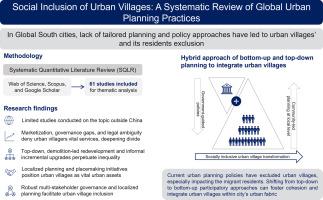Social inclusion of urban villages: A systematic review of global urban planning practices
IF 6.6
1区 经济学
Q1 URBAN STUDIES
引用次数: 0
Abstract
Urban villages, erstwhile rural areas absorbed by expanding cities due to unprecedented urbanization, are a growing phenomenon in many developing nations. These villages are often ignored by the policymakers, despite their economic contributions. Today, integration of urban villages into formal city planning persists as a substantial challenge, especially in the Global South. The lack of specific village planning strategies has aggravated their marginalization from the broader urban environment. To better understand this challenge, this study uses a Systematic Quantitative Literature Review (SQLR) methodology to explore global urban planning practices contributing to the social inclusion and exclusion of urban villages. By using a thematic framework, the research reveals how dynamics like urbanization and migration drive emergence of high-density, mixed-use urban villages, enduring substandard built-environment and socio-spatial segregation. The review identifies demolition-led redevelopment, incremental upgradation, and self-help mechanisms, as exclusionary paradigms hindering villages' inclusion. Five inclusive approaches: urban design and placemaking; in-situ redevelopment; community-driven incrementalism; responsive governance; and socio-economic support emerge as effective mechanisms towards urban villages' integration. The review calls for a paradigm shift towards inclusive, context-specific participatory planning approaches, prioritizing residents' needs over economic benefits. There are also significant geographic gaps in the existing scholarly literature in relation to inclusive urban village planning and governance globally. Hence, the paper calls for a more geographically inclusive research agenda, exploring cross-context comparative case studies of urban villages particularly from underrepresented geographies, utilizing a multi-lingual approach to deepen understanding. The findings inform policymakers and practitioners in formulating just and socially inclusive urban village development.

城中村的社会包容:全球城市规划实践的系统回顾
城中村,即由于空前的城市化而被不断扩大的城市所吸收的以前的农村地区,在许多发展中国家日益成为一种现象。尽管这些村庄在经济上做出了贡献,但它们经常被政策制定者忽视。今天,将城中村纳入正式的城市规划仍然是一项重大挑战,特别是在全球南方国家。缺乏具体的村庄规划战略,加剧了它们在更广泛的城市环境中的边缘化。为了更好地理解这一挑战,本研究采用了系统定量文献综述(SQLR)方法来探讨全球城市规划实践对城中村社会包容和排斥的影响。通过使用主题框架,研究揭示了城市化和移民等动态因素如何推动高密度、混合用途的城中村的出现,以及持续不合标准的建筑环境和社会空间隔离。报告指出,拆迁主导的再开发、渐进式改造和自助机制是阻碍村庄包容性的排他性模式。五种包容性方法:城市设计和场所营造;现场重建;社区驱动的渐进主义;响应治理;社会经济支持成为城中村一体化的有效机制。该报告呼吁将模式转变为包容性的、具体环境的参与式规划方法,将居民的需求置于经济利益之上。在全球范围内,关于包容性城中村规划和治理的现有学术文献也存在显著的地理差距。因此,本文呼吁建立一个更具地理包容性的研究议程,探索城中村的跨语境比较案例研究,特别是在代表性不足的地区,利用多语言方法加深理解。研究结果为政策制定者和实践者制定公正和社会包容的城中村发展提供了参考。
本文章由计算机程序翻译,如有差异,请以英文原文为准。
求助全文
约1分钟内获得全文
求助全文
来源期刊

Cities
URBAN STUDIES-
CiteScore
11.20
自引率
9.00%
发文量
517
期刊介绍:
Cities offers a comprehensive range of articles on all aspects of urban policy. It provides an international and interdisciplinary platform for the exchange of ideas and information between urban planners and policy makers from national and local government, non-government organizations, academia and consultancy. The primary aims of the journal are to analyse and assess past and present urban development and management as a reflection of effective, ineffective and non-existent planning policies; and the promotion of the implementation of appropriate urban policies in both the developed and the developing world.
 求助内容:
求助内容: 应助结果提醒方式:
应助结果提醒方式:


